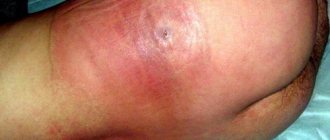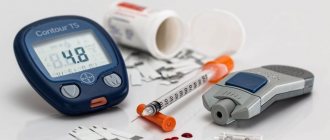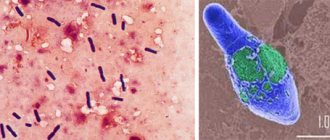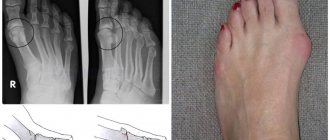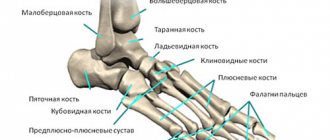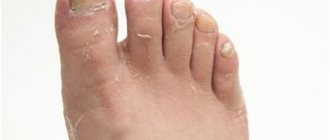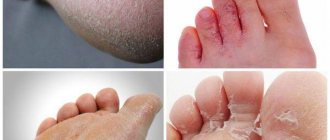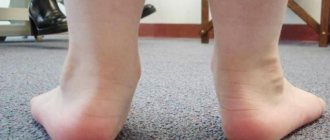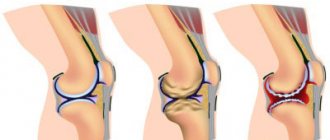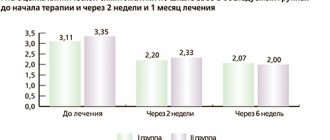03.02.2021
The onset of old age is often accompanied by a deterioration in health; older people suffer from chronic diseases and their exacerbations. One of the most severe conditions that are diagnosed in old people is gangrene of the lower extremities. The disease is characterized by its insidiousness and rapid increase in symptoms, leads to disability of the sick person and can cause death.
Few people know that, in accordance with the current legislation of the Russian Federation, elderly parents have the official right to receive financial assistance from their children. Alimony can be received by pensioners, persons with disabilities who have lost the ability to independently provide for their existence. If the future heir refuses to voluntarily fulfill the obligations assigned to him, the elderly parents can go to court.
What is gangrene
Gangrene is the process of tissue death of body parts or organs with a color change in the area of death from blue to black. The darkening of the tissue is caused by the presence of iron sulfide, which is formed when hemoglobin in the blood is destroyed. This disease can affect not only the limbs, but also the lungs, intestines or gall bladder.
Based on the type of dead tissue, gangrene is divided into dry and wet.
With dry gangrene, which most often affects the extremities, the blood vessels become clogged slowly. This process takes months or even years. The body's protective reaction allows it to independently isolate healthy tissue from damaged tissue (usually the fingers or feet are affected first). The dead tissue dries out, while practically no decay occurs, there is no smell or intoxication of the body. If dry gangrene does not turn into wet gangrene, then there is no direct threat to the patient’s life, but there is a danger of complications. To avoid complications, as well as for cosmetic purposes, blackened necrotic tissue is amputated.
Wet gangrene develops acutely, as a result of rapid blockage of blood vessels, while infection is always present. The root cause of the disease is frostbite, injury, burn or acute arterial insufficiency. The affected tissue is enlarged in volume and filled with hydrogen sulfide, has a corpse-like appearance and smell, and color ranges from greenish to purple. To save the life of an elderly person, surgical removal of the diseased organ is performed. Both limbs and internal organs can be affected.
Diagnostics
Diagnosis of gangrene is not difficult and includes:
- Inspection of the affected area (visual);
- Arterio- or phlebography;
- Ultrasound Doppler examination of blood vessels;
- Rheovasography;
- CT and MRI;
- Duplex scanning with contrast agent;
- General blood analysis;
- Blood chemistry;
- Bacteriological examination of biomaterial taken from the affected area.
A correct diagnosis can be made in all cases.
Causes of gangrene
- Impaired blood supply to tissues (incorrectly applied plaster, which restricts the movement of blood, heavy pressure on the body. For example, in car accidents or under rubble, when a medical tourniquet is applied for a long time to stop bleeding). Basically, in such cases, the limbs are damaged and a dry type of gangrene develops.
- Diseases of the heart or blood vessels (atherosclerosis, thrombosis and others).
- Bacterial infection (microbes that get into the wound - streptococci, proteus, enterobacteria, etc. can give rise to the disease).
- Frostbite, burns, including chemical burns (in damaged areas, blood supply is disrupted and inflammation begins, which, if infected, can provoke disease).
- Mechanical injuries aggravated by infections.
Establishing diagnosis
Gas gangrene is characterized by a necrotizing (flesh-destroying) bacterial infection that can be recognized by a doctor. The doctor will take a tissue sample or perhaps some fluid from the blisters. The sample is tested in the laboratory. However, treatment will not wait for results. The doctor will immediately begin giving you a broad-spectrum antibiotic.
If the infection is severe, sometimes an X-ray or MRI of the soft tissue is used to detect gas deep under the skin. If surgery is required, these scans will indicate exactly where the bacteria are and what needs to be removed.
Why does gangrene of the lower extremities begin in old age?
Of all the types of this disease, the most common among older people is gangrene of the lower extremities.
- weakened state in old age;
- prolonged immobilization;
- lack of vitamins;
- smoking, alcoholism;
- somatic diseases;
- metabolic disorders in the body;
- hypothermia of the body.
The causes of gangrene of the lower extremities in older people are very different. A significant proportion of those suffering from this disease are patients with diabetes, since high blood sugar destabilizes the functioning of all organs and systems, including the functioning of blood vessels.
The underlying factor of the disease is poor circulation in older people. Not enough nutrients and oxygen enter the tissue, so the ability to heal wounds deteriorates. Even small wounds, scratches, and cuts become non-healing ulcers.
Prognosis and prevention
In order to prevent “diabetic foot” syndrome, when persistent ulcers and elements of necrosis appear on the legs, in diabetes mellitus it is important to carefully monitor the condition of the legs.
Photo: aliced / Depositphotos The prognosis for life with dry gangrene is favorable, but it is impossible to preserve the necrotic area and restore blood supply to it - it is either amputated surgically or rejected without medical intervention. After amputation there follows a period of rehabilitation (about 3-6 months) and selection of a prosthesis.
To prevent gangrene, you must follow a number of recommendations:
- dress according to the weather, do not neglect warm gloves and woolen socks in the cold season;
- avoid the risks of hypothermia and do not engage in extreme sports without good preparation, for example, do not climb snow-capped mountain peaks;
- If you have diabetes, you need to carefully monitor the condition of the skin, monitor blood glucose levels, and undergo regular examinations;
- watch your weight, eat right;
- do not smoke or abuse alcoholic beverages;
- For any injuries or bruises, consult a doctor.
First aid in case of injury threatening necrosis
To avoid the development of gangrene and death of living tissue, it is useful to know how to cope with injuries (burns, frostbite, consequences of electric shock) if medical help is unavailable for some reason (Fig. 3).
Figure 3. First aid for injuries. Source: MedPotral
Symptoms of dry gangrene of the leg in the elderly
- this type often appears in weakened old people, thin and prone to dehydration;
- at first the person feels acute pain in the limb (until the tissue dies), the skin is pale and cold;
- it is not possible to feel the pulse in the arteries of the diseased leg;
- often gangrene begins from the toe of an elderly person and reaches a place with normal blood flow (the lesion is limited to a certain area and does not spread to a healthy neighboring area);
- gradually the tissue dries out, wrinkles and decreases in volume, mummification occurs;
- a sick person cannot move his leg and does not feel it;
- fabric color - from dark brown to bluish-black;
- the line between healthy and necrotic tissue (demarcation) is very pronounced;
- if medical amputation is not done, then sometimes the body independently rejects necrotic tissue;
- the patient feels relatively well, there is practically no intoxication.
Which symptoms should be given more importance?
The first signs of gangrene are severe pain, which can be eliminated exclusively with the help of analgesics. In addition, a change in skin color is considered a primary indicator. It is possible to establish the presence of gangrene in the internal organs due to the deterioration of the general condition.
The negative side will be the presence of diabetes mellitus, so patients with such pathology are advised to be more attentive and not turn a blind eye to the first signs. Damage to blood vessels, burns, radiation sickness play a negative role in the spread of gangrene of the arms , legs, and the like.
Symptoms of wet gangrene
- wet gangrene of the leg usually begins in an overweight, edematous elderly person;
- the skin is initially pale and cold, severe swelling is observed, the venous network is visible, the pulse in the arteries of the leg cannot be felt;
- dark red spots appear on the skin;
- inflammation progresses rapidly, there is no demarcation shaft between healthy and diseased areas;
- the affected tissues do not dry out, but turn black and decompose (there is a strong smell of rotting);
- decomposition products enter the bloodstream and severe intoxication occurs;
- the elderly person’s condition is very serious, he is bothered by intense pain and high fever; pulse is increased, blood pressure is low;
- the patient's refusal to eat and drink;
- spread of infection leads to sepsis and death.
In what cases should you urgently consult a doctor?
There are a number of symptoms, the appearance of which may indicate a predisposition or the onset of gangrene of the leg in an elderly person, and requires contacting a medical institution for consultation and diagnosis of the disease:
- constantly cold feet (even in the summer heat);
- fatigue when walking and pain in the legs;
- cramps in the limbs;
- poor healing of even minor wounds;
- loss of sensation in the affected area;
- change in the skin from pale to bluish or marbled, and then to black (in later stages of the disease);
- the patient's refusal to eat and drink;
- non-healing ulcers.
Under no circumstances should these symptoms be ignored. There is a very fine line between dry and wet gangrene, which develops rapidly and poses a threat to the life of an elderly person, especially if the elderly person has high blood sugar. Immediate consultation with a doctor, prevention and treatment will help prevent the development of a serious illness leading to disability and death.
Gangrene can be treated without amputation at the Innovative Vascular Center
Treatment of gangrene without amputation in Moscow is carried out in a specialized hospital of the Innovative Vascular Center - the Clinic of Innovative Surgery (CIS). In 2011, according to the ROASH report, our clinic took a leading position in performing vascular reconstructions on the arteries of the leg and foot.
The Innovative Vascular Center is a clinic in Russia where modern high-tech methods of restoring blood flow in the legs, advanced technologies of X-ray endovascular surgery, vascular and reconstructive plastic microsurgery are put into use.
Every year we successfully operate on more than 650 patients with critical ischemia and gangrene of the legs. Modern treatment of gangrene can be carried out by a team of experienced vascular and endovascular surgeons, as well as doctors skilled in the management and closure of necrotic wounds. Such a team can achieve impressive results in the treatment of gangrene. This team must include specialists who not only know how to restore blood flow, but who also know how to treat a patient with multiple vascular lesions, severe comorbidities and serious wound complications.
Wet gangrene, necrosis, long-term non-healing wounds, and black color of the finger are not a reason for amputation for our team, but should be the reason for active surgical tactics to save the limb. We manage to save the leg in most patients with threatening limb ischemia. We are fighting to save our leg until the last possible moment.
In many other “limb salvage centers” there is a separation of vascular, endovascular and reconstructive plastic surgery, so there is no possibility of a holistic approach to the treatment of critical limb ischemia.
Treatment
Most often, gangrene appears in an elderly bedridden person. The first thing such a patient needs to do is check the capacity of the blood vessels and organize special care for him.
Beginning ischemic gangrene in the lower limb requires urgent restoration of blood circulation. To limit the affected area and preserve the supporting function of the limb (in more advanced stages), operations are performed on the blood vessels, and then, after restoring blood supply, dead tissue is removed or the affected part of the limb is amputated (depending on the extent of the damage). Untreated dry gangrene in the vast majority of cases is complicated by damage to the heart, lungs, liver or kidneys, which ultimately leads to death.
In the infectious form of this disease, to save the patient's life, amputation is carried out immediately, and tissues and organs damaged by gangrene are treated with penicillin injections.
High amputation (above the knee)
Gritty hip amputation
Our clinic uses a method of amputation for gangrene of the lower leg, which is promising for prosthetics, if it is impossible to perform amputation of the lower leg. This amputation preserves the patella (“kneecap”) and creates a supporting, long and strong stump on which a lightweight prosthesis without pelvic attachment is used. The operation is technically more complex than simple hip amputation, but the results of prosthetics are much better and are comparable in rehabilitation to lower leg amputation. Our clinic has very positive experience with such amputations.
Video after hip amputation according to Gritty
Prevention of gangrene in private nursing homes “Longevity”
In the Longevity boarding houses, elderly guests are provided with comprehensive services, including regular examinations by doctors, as well as a set of preventive measures to prevent the development of this serious illness. At the initial stage, the disease can be prevented or the process of necrosis can be stopped in time. Experienced boarding house specialists know how gangrene begins in the elderly, what it looks like, so they can easily detect not only the beginning of gangrene, but also its precursors by the symptoms.
In addition, our guests are provided with:
- full care and supervision for the elderly and sick 24 hours/7 days a week (for bedridden patients - special medical beds with anti-decubitus mattresses);
- 5-6 balanced meals a day (dietary meals are prescribed if necessary);
- comfort in the rooms, choice of accommodation (1, 2, 3-bed rooms);
- individual psychological assistance, organized leisure, walks, interest groups.
The boarding houses are located in quiet and cozy places in Moscow and the Moscow region (in Ramenskoye, Vidnoye, Zelenograd, Belozerki). All houses have their own fenced area with picturesque nature.
Our guests, no matter how severe their illnesses, do not feel lonely and abandoned. Here they always feel support, help and confidence in the future.
